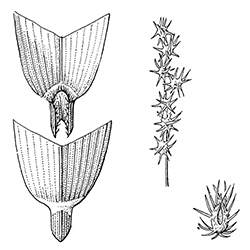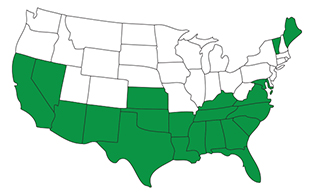

Sandbur
Cenchrus
Sandbur is an annual grassy weed that is also know as Cenchrus spinifex, Coastal Sandbur or by its scientific name, Distichlis stricta. Just like a burr in the woods, this lawn weed can be painful to touch.
Identify

Bunch

Folded

Hairy
Sandbur can be identified as a yellow-green annual grassy weed with a tendency to spread and creep. It typically grows vertically, but this lawn weed can occasionally form mats. It has a broad collar—sometimes with sparse hairs on the edges—and its sheaths are loose and flattened, also with sparse hairs on the edges. Sandbur has flat blades that are sometimes folded and taper to a point. The upper blades often enclose burs. Sandbur forms seed heads that first appear around July. Each seed head is a spike with anywhere from six to 20 burs. The spiny burs of this grass-like weed can be painful to the touch.
Life Cycle
This lawn weed prefers dry, sandy and sandy loam soils, and can often be found growing in old fields, sandy flood plains, waste areas and poorly maintained lawns. Sandbur occurs in most parts of the southern half of the United States. These grassy weeds are also annuals, meaning they live for only one season and are typically easy to control because they lack the complex underground structures needed to spread new plant growth through creeping roots. Still, annuals produce tons of seeds that can infest and dominate your yard under the right conditions.

Control
Sandbur is an invasive and sometimes noxious lawn weed that can cause injury to domestic and grazing animals, as well as people. This grassy weed is difficult to manage in landscaped areas and lawns. For effective weed removal, professionally selected and applied weed control treatments are your best bet for eradication.







